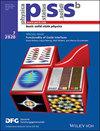Spin–Orbit Coupling Effect Bandgaps Engineering of the Lead‐Free Perovskites FABI3 (B = Sn or Ge) Materials for Tandem Solar Cells: First Principle Investigation of Structural and Electronic Properties
IF 1.8
4区 物理与天体物理
Q3 PHYSICS, CONDENSED MATTER
引用次数: 0
Abstract
Pb‐free perovskites are novel compounds that are currently being studied, essentially for their photovoltaic applications. In this article, the hybrid organic–inorganic perovskite for photovoltaic applications is studied. In fact, the structural and electronic properties of the perovskite FABI3 (B = Sn, Ge, or Pb and FA = formamidinium: CH(NH用于串联太阳能电池的无铅透镜材料 FABI3(B = Sn 或 Ge)的自旋轨道耦合效应带隙工程:结构和电子特性的第一原理研究
无铅过氧化物是目前正在研究的新型化合物,主要用于光伏应用。本文研究了用于光伏应用的有机-无机混合型过氧化物。事实上,FABI3(B = 锡、锗或铅,FA = 甲脒:CH(NH2)2)的结构和电子特性,并在量子 Espresso 框架下应用密度泛函理论方法进行了研究和讨论。结果表明,这些包晶具有半导体性质,FASnI3 的带隙值为 1.36 eV,FAGeI3 为 1.72 eV,FAPbI3 为 1.61 eV。此外,还介绍并讨论了每种材料的状态密度和部分状态密度。事实上,对这些包晶的结构特性进行了研究,结果表明 FASnI3 的优化晶格参数值为 6.35 Å,而 FAGeI3 的优化晶格参数值为 6.3 Å,FAPbI3 的优化晶格参数值为 6.5 Å。此外,还研究了晶格参数对 FABI3(B = Sn、Ge 或 Pb)带隙值的影响,结果表明,随着晶格参数的增加,带隙也会增加。这项工作的结果可作为开发新型高效无铅过氧化物器件(包括串联太阳能电池)的指南。
本文章由计算机程序翻译,如有差异,请以英文原文为准。
求助全文
约1分钟内获得全文
求助全文
来源期刊
CiteScore
3.30
自引率
6.20%
发文量
321
审稿时长
2 months
期刊介绍:
physica status solidi is devoted to the thorough peer review and the rapid publication of new and important results in all fields of solid state and materials physics, from basic science to applications and devices. Being among the largest and most important international publications, the pss journals publish review articles, letters and original work as well as special issues and conference contributions.
physica status solidi b – basic solid state physics is devoted to topics such as theoretical and experimental investigations of the atomistic and electronic structure of solids in general, phase transitions, electronic and optical properties of low-dimensional, nano-scale, strongly correlated, or disordered systems, superconductivity, magnetism, ferroelectricity etc.

 求助内容:
求助内容: 应助结果提醒方式:
应助结果提醒方式:


